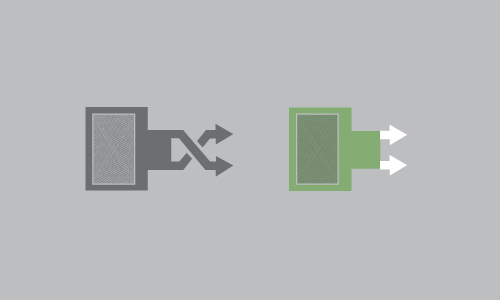Throughout the air pollution control system consultation process, you will be presented with a lot of information from a wide range of vendors, all of whom have slightly different design elements that affect the price, destruction efficiency, thermal efficiency, and operating costs.
Understanding the Difference: Random Media vs. Structured Media
As VOC Abatement Solutions are reliable and may last decades (with the right maintenance), you may not have been exposed to the changes in the market or may just know about your current system. This said, differences can have big impacts on the ongoing operation of your new system, affecting everything from reliability to costs.
One of the factors you may have to select when looking at an RTO is the choice of heat recovery media. This choice, alongside the decision between two-chamber RTOs and three- five- and seven-chamber RTOs affects everything from pressure to heat retention, in turn affecting the amount of fuel used, thermal efficiency, and destruction efficiency. Today, we would like to look at the different types of ceramic media used and explore how they affect RTO operation.
What is Ceramic Media and What is it Used For?
To understand the importance of and use for ceramic media, you must first understand how an RTO works. During the VOC destruction process, ceramic media is used to maintain the heat necessary to destroy VOCs. An RTO works by directing process exhaust fumes into one of the chambers, directing the air into one of these chambers using an inlet valve.
The pollutant laden air passes from the valve assembly vertically upward through the first of the heat exchanger canisters where it adsorbs heat from the ceramic media, then entering the combustion chamber at a temperature near that which is required for destruction.
When pollutant-laden air passes through the ceramic media and adsorbs heat, the ceramic media eventually cools. An RTO is designed to pass hot, clean air from the combustion chamber to the unused chamber, preheating the ceramic media before being routed to the atmosphere. The continuous switching process provides increased efficiency by preheating the unused chamber.
Structures of Ceramic Media Available in an RTO
Bed size and packing type are selected based on waste gas flow and composition. Enough pounds of packing have to be used to absorb the heat from the full flow of stack gas – once a layer of packing is heated to combustion chamber temperature, it can’t pick up any more energy and another layer has to be added.
Random Media
Random packed media comes in a variety of shapes, with the most common shape being a saddle. While this choice does allow for easy installation, replacement, or removal, excellent heat storage characteristics, and lower costs than structured media, random media faces increased risk of pressure drop and particulate plugging, as well as an increased RTO size.
Any pressure drop requires increased airflow to negate the drop, increasing the electricity required to power the exhaust fan, in turn driving operating costs higher. Knowing this, random media has evolved in recent years to reduce pressure drop in an RTO, making these more viable than in years prior.
Structured Media
Coming in a variety of designs including multi-layer media, structured media packs a high density of ceramic into a small area, allowing for a smaller RTO footprint.
Providing lower levels of pressure drop, smaller space requirements and faster adsorption of heat, structured heat exchange media also loses heat faster than its unstructured counterpart, ultimately requiring shorter periods of chamber switching. Shorter cycle times mean more chamber switching, in turn increasing the ‘puff’ as well as the wear on valves.
Additionally, structured media requires more accurate measurement and is more challenging to install and replace than random heat exchange media.
Monolith Media
By definition a subset of structured media, Monolith/Honeycomb Ceramic Heat Exchange Media is designed to increase the surface area of the ceramic media to provide more efficiency per unit of volume. Similarly to structured media, it offers minimal pressure drops, but requires more frequent cycling due to rapid heat dissipation.
Monolith is measured in ‘cells per inch’ coming in a variety of geometries. Narrow monolith cells can be used when there is little to no risk for particulate clogging.
Learn More
Whether looking for your options when purchasing a new pollution control system or need preventative or ongoing maintenance, we’re here to help.
VOC Abatement Guide
If you are looking to understand your options when selecting VOC abatement options, we invite you to download our free guide to VOC Abatement Technologies. This guide is designed to educate you about volatile organic compounds, direct and indirect health and environmental effects, the role of regulators in ensuring manufacturers cut back on VOC emissions, and some of the most effective ways to remove VOCs from your manufacturing processes.
CMM Group Ceramic Media Inspection and Replacement Services
As part of preventative maintenance, the CMM Group provides ceramic media inspection and replacement for Regenerative Thermal Oxidizers (RTOs), Thermal Oxidizers, and Rotary Concentrators (both CMM and other makes). CMM Group provides complete and turnkey ceramic media replacement including inspection, removal and installation, and repairs. CMM Group can supply all types of ceramic media including random packing, and structured ceramic media.




